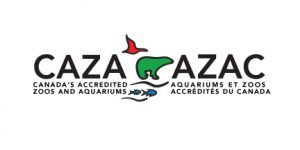Education
A method that many welfare organizations have employed is increasing the knowledge of welfare issues of animals in captivity.
World Society for the Protection of Animals
This organization aims to free animals from suffering and among their resources are school programs geared towards learning about animal welfare in a school setting. As well, they have activities people can partake in to gain a better understanding of welfare.

Learn more about World Animal Protect at https://www.worldanimalprotection.ca/our-work/animal-welfare-education
Welfare Accreditation
 “The CAZA logo displayed alongside a zoo or aquarium’s name signifies excellence in animal care and management and a commitment to conservation and education.” – CAZA
“The CAZA logo displayed alongside a zoo or aquarium’s name signifies excellence in animal care and management and a commitment to conservation and education.” – CAZA
Canada’s Accredited Zoos and Aquariums (CAZA) is an organization that promotes animals welfare by granting certifications to zoos and aquariums for meeting set standards when it comes to the enrichment of animal’s lives. They use five encompassing factors when looking at animal welfare adopted from Mellor and Beausoleil: nutrition, environment, health, behavior and the mental domain (Mellor and Beausoleil, 2015).
To learn more about CAZA, please visit http://caza.ca
Regulation
In Canada, the operating licenses and permits to own a zoo are granted by the provincial/municipal government.
In Ontario, Bill 154 (Regulation of Zoos Act) has a subsection on the standard of care for the animals at the zoo in which the owners must be able to provide for each individual’s and species’ needs (Legislative Assembly of Ontario, 2006).
In British Columbia, there is little regulation of Zoo animals with regards to welfare. BC Law permits have guidelines for the number of animals per species that can be housed at each zoo as well as their age (BCLaws, 2000). For instance, a zoo permit only allows up to 20 elk over 2 years of age per facility (BCLaws, 2000).
While there are regulations in place, welfare standards are inadequate and unregulated. There must be an increase in the number of laws relating to the health and well-being of the animals in captivity. As well, there must be more regulations that are species specific to acknowledge the differences between each individual animal.



